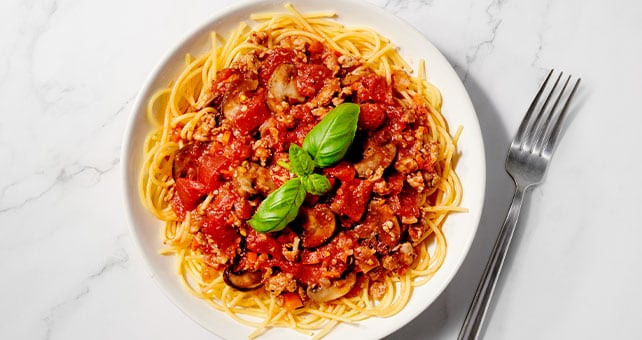Updated March 18, 2024
Sometimes it is easy to get off track on your wellness journey. Holidays, busy schedules, and other obligations may keep you from focusing on your health. But you can get back on track. Typically, spring is a great time to clean and reorganize, replacing the old with the new. It’s also a great way to start new healthy habits. Here are a few tips to get a head start in your spring health goals.
Recipes.
Keep a food journal.
There are many ways to keep track of what you eat. You can write it down on paper, keep notes on your computer or digital device, or use a diet tracking website or app. Some studies have shown that keeping a food log not only helps you assess where you are, but it also helps increase your chances of success. Studies have shown that people who keep track of what they eat, no matter the method, have better success at losing weight, managing their diet, controlling their portions, and sticking to healthy habits. Here are a few tips to keep in mind when keeping a food journal.
Extras add up.
Remember, if you bite it, you write it. Include the extras that add up, such as that handful of candies at the office or foods that you taste during cooking.
Record as you go.
If possible, record immediately after eating. Or, if you are in a hurry, snap a picture with your phone so you can enter the foods later.
Don't skip your indulgent days.
Include holidays, parties, and the weekends.
Pay attention to portion sizes.
It is easy to underestimate how much you have eaten. Measure your foods using measuring cups, spoons, or even a food scale.
Be specific.
Make sure you include “extras,” such as gravy on your meat, cheese on your sandwich, or vegetables, butter, and salad dressings.
Set realistic goals.
Refine your goals by targeting a specific area for improvement. Goals should also be measurable, time-related, and most importantly, realistic. Carefully plan your goals and consider how they will fit best into your lifestyle. If you tend to eat out several times a week for lunch, this might be an opportunity to make better choices. For example, set a goal to eat out only twice a week. On the other days, plan to pack your lunch in a cooler to take with you.
Nutrition goal examples.
- I want to eat better. I plan to bring fruits, yogurt, and unsalted nuts for snacks instead of buying chips from the vending machine.
- I need to eat more vegetables. I plan to eat salads for lunch and have 2 servings of vegetables at dinner.
- I must drink more water. I will drink at least 64 ounces of water per day at least 5 days per week. I will drink a glass of water before drinking anything else.
Spring-clean your pantry.
You won't be able to see what you have in your home, what you need to toss out, and what you need to buy until you've completely removed everything from your pantry. Consider these tips to get organized.
Take inventory.
Go through your pantry and pull out absolutely everything. Split your items into two piles: things you use and want to keep, and foods you haven't touched in at least three to six months. Consider donating the items you don't plan on using and tossing items that are out of date.
Check the dates.
Start by checking the expiration dates on foods. For products that do not have expiration dates, such as oils and spices, there are resources such as the USDA FoodKeeper App* to help you understand freshness and quality of these items.
*By clicking the link above, you will leave www.publix.com and enter the FoodSafety website that they operate and control.
Check ingredients.
Remove foods with partially hydrogenated oils, artificial colors and flavors, or foods high in saturated fat and/or with added sugars and sodium.
Create zones.
When reorganizing your food, think of how grocery store aisles are arranged. Group your pantry items by type: grains, drinks, baking items, canned goods, soups, snack foods, etc. This will make it easier to identify the items you need when heading to the store or making a meal.
Restock.
Now that your pantry is clean, it's time to restock. Plan ahead by creating a customized list with My Shopping List to make grocery shopping easier. When putting away your purchases, put foods you want to eat more of (e.g., canned fruits and vegetables) in your field of vision (on countertops or on eye-level shelves), and foods you want to eat less of hidden (top or bottom shelf behind other foods).
Make a list.
Keep a running grocery list on your refrigerator. When one of your pantry items runs low, add it to the list so you remember to purchase it during your next trip to the supermarket.
Helpful tools from Publix.
We have a variety of tools for you. From shopping lists to recipes, we can help you get a head start in your springtime health goals.
Shopping lists.
Do you have a specific dietary concern? Are you watching your sodium intake or avoiding gluten? Check out our shopping lists for The Right Foods for You which includes food options for Gluten Free, Low Sodium, Low Fat, and Five Grams of Sugar or Less.
Shelf tags.
We've made it easier to shop according to your dietary needs and goals with unique shelf tags. We've clearly labeled our products using Better Choice and teal shelf tags for organics, plus gluten-free, vegan, and Made Without icons—so you can identify your best option at a glance.
Recipes.
Our chefs have developed recipes for several different dietary considerations, including gluten-free, lacto-ovo vegetarian, and kosher. Also, recipes designated as Better Choice, Carb Smart, or Heart Smart provide simple yet delicious options for your family.
For the love of you.
Choosing how you eat is uniquely personal. It’s about your needs, your preferences, and your goals. As your wellness ally, we’re in your corner with fresh ideas, recipes, and wellness icons that make it easier to shift toward wiser food choices. It’s all about you, at your very best.
Source:
Burke, Lora E., Jing Wang, and Mary Ann Sevick. Self-Monitoring in Weight Loss: A Systematic Review of the Literature. National Library of Medicine. January 2011.

 You are about to leave publix.com and enter the Instacart site that they operate and control. Publix’s delivery and curbside pickup item prices are higher than item prices in physical store locations. Prices are based on data collected in store and are subject to delays and errors. Fees, tips & taxes may apply. Subject to terms & availability. Publix Liquors orders cannot be combined with grocery delivery. Drink Responsibly. Be 21. For prescription delivery, log in to your pharmacy account by using the Publix Pharmacy app or visiting
You are about to leave publix.com and enter the Instacart site that they operate and control. Publix’s delivery and curbside pickup item prices are higher than item prices in physical store locations. Prices are based on data collected in store and are subject to delays and errors. Fees, tips & taxes may apply. Subject to terms & availability. Publix Liquors orders cannot be combined with grocery delivery. Drink Responsibly. Be 21. For prescription delivery, log in to your pharmacy account by using the Publix Pharmacy app or visiting 
